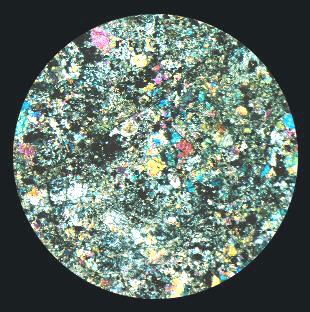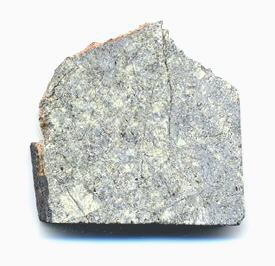NWA 2092
LL6/7
purchased 2003
no coordinates recorded A fresh (W1), mostly complete stone, weighing 320 g, was purchased in Morocco by an American dealer. A portion of the meteoriteWork in progress. A solid natural object reaching a planet’s surface from interplanetary space. Solid portion of a meteoroid that survives its fall to Earth, or some other body. Meteorites are classified as stony meteorites, iron meteorites, and stony-iron meteorites. These groups are further divided according to their mineralogy and Click on Term to Read More was sent to Northern Arizona University for classification (T. Bunch and J. Wittke), and it was determined that NWA 2092 is a transitional type LL6/7. Features of this chondriteChondrites are the most common meteorites accounting for ~84% of falls. Chondrites are comprised mostly of Fe- and Mg-bearing silicate minerals (found in both chondrules and fine grained matrix), reduced Fe/Ni metal (found in various states like large blebs, small grains and/or even chondrule rims), and various refractory inclusions (such Click on Term to Read More, such as brecciationThe formation of a breccia through a process by which rock fragments of of various types are recemented or fused together. Click on Term to Read More, thermal annealing along fractures and clastA mineral or rock fragment embedded in another rock. Click on Term to Read More borders, and a variable grain size in the matrixFine grained primary and silicate-rich material in chondrites that surrounds chondrules, refractory inclusions (like CAIs), breccia clasts and other constituents. Click on Term to Read More are consistent with a shock metamorphismMetamorphism produced by hypervelocity impact between objects of substantial size moving at cosmic velocity (at least several kilometers per second). Kinetic energy is converted into seismic and heat energy almost instantaneously, yielding pressures and temperatures far in excess those in normal terrestrial metamorphism. On planetary bodies with no atmosphere, smaller Click on Term to Read More/recrystallization event; the shock stageA petrographic assessment, using features observed in minerals grains, of the degree to which a meteorite has undergone shock metamorphism. The highest stage observed in 25% of the indicator grains is used to determine the stage. Also called "shock level". Click on Term to Read More is S3.
- the presence of poorly defined chondrulesRoughly spherical aggregate of coarse crystals formed from the rapid cooling and solidification of a melt at ~1400 ° C. Large numbers of chondrules are found in all chondrites except for the CI group of carbonaceous chondrites. Chondrules are typically 0.5-2 mm in diameter and are usually composed of olivine Click on Term to Read More in type 6, but only relict chondrules in type 7
- low-Ca pyroxenes in type 6 contain no more than 1.0 wt% CaO (1.0 wt% = ~1.9 mol% Wo), but more than 1.0 wt% in type 7; conversely, the CaO content of high-Ca pyroxenes decreases from type 6 to type 7
- feldsparAn alumino-silicate mineral containing a solid solution of calcium, sodium and potassium. Over half the Earth’s crust is composed of feldspars and due to their abundance, feldspars are used in the classification of igneous rocks. A more complete explanation can be found on the feldspar group page. Click on Term to Read More grains gradually coarsen to reach a size of at least 0.1 mm in type 7
In the intervening time since Dodd et al. proposed their classification parameters, additional type 7 chondrites have been found and studied. Following more recent studies at Northern Arizona University, it was proposed by T. Bunch (pers. comm., 2004) that a type 7 category should not comprise meteorites containing any relict chondrules (such as those present in low abundance in NWA 2092), but rather, should represent a metamorphic extreme in which no sign of chondrules remains. This would lump those meteorites containing ‘poorly defined’ chondrules, and those containing ‘relict’ chondrules, into the type 6 category. Following the present scheme of Dodd et al. however, the presence of relict chondrules in NWA 2092 is still consistent with an assignment as type 7.
The low-Ca pyroxeneA class of silicate (SiO3) minerals that form a solid solution between iron and magnesium and can contain up to 50% calcium. Pyroxenes are important rock forming minerals and critical to understanding igneous processes. For more detailed information, please read the Pyroxene Group article found in the Meteoritics & Classification category. Click on Term to Read More in NWA 2092 has an average CaO content of 1.0 wt%, which is consistent with a borderline, transitional 6/7 type (strictly defined, perhaps a Dodd type 6). Furthermore, the size of plagioclaseAlso referred to as the plagioclase feldspar series. Plagioclase is a common rock-forming series of feldspar minerals containing a continuous solid solution of calcium and sodium: (Na1-x,Cax)(Alx+1,Si1-x)Si2O8 where x = 0 to 1. The Ca-rich end-member is called anorthite (pure anorthite has formula: CaAl2Si2O8) and the Na-rich end-member is albite Click on Term to Read More grains was used by Dodd et al. to delimit a boundary between types 6 and 7: the coarsening of grains to at least 0.1 mm defines a type 7. However, Bunch and Wittke suggest that the relative size of all of the silicates would provide a better gauge—silicates attain an equigranular texture only under the highest metamorphism. They have also discovered that simple twinning of plagioclase occurs only in type 7, and suggest that this could be utilized as an additional parameter. Furthermore, it was revealed by Bunch and Wittke that modal metalElement that readily forms cations and has metallic bonds; sometimes said to be similar to a cation in a cloud of electrons. The metals are one of the three groups of elements as distinguished by their ionization and bonding properties, along with the metalloids and nonmetals. A diagonal line drawn Click on Term to Read More contents decrease significantly during late metamorphic stages; i.e., low-Ni metal, as well as pyroxenes, are consumed to produce olivineGroup of silicate minerals, (Mg,Fe)2SiO4, with the compositional endpoints of forsterite (Mg2SiO4) and fayalite (Fe2SiO4). Olivine is commonly found in all chondrites within both the matrix and chondrules, achondrites including most primitive achondrites and some evolved achondrites, in pallasites as large yellow-green crystals (brown when terrestrialized), in the silicate portion Click on Term to Read More, resulting in only small amounts of Ni-rich metal and lower amounts of orthopyroxeneOrthorhombic, low-Ca pyroxene common in chondrites. Its compositional range runs from all Mg-rich enstatite, MgSiO3 to Fe-rich ferrosilite, FeSiO3. These end-members form an almost complete solid solution where Mg2+ substitutes for Fe2+ up to about 90 mol. % and Ca substitutes no more than ~5 mol. % (higher Ca2+ contents occur Click on Term to Read More and clinopyroxene compared to those amounts in lower metamorphic grades. Based on all of the data, it was concluded that NWA 2092 best fits a transitional 6/7 classification. The photo above shows a 2.38 g partial slice of NWA 2092. The photo below is a thin sectionThin slice or rock, usually 30 µm thick. Thin sections are used to study rocks with a petrographic microscope. in crossed polarized light which shows the variable grain size of the silicates.
Photo courtesy of T. Bunch—NAU







